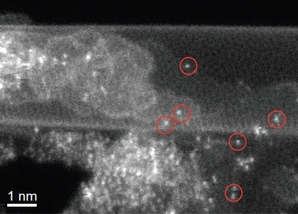ORNL microscopy reveals workings behind promising inexpensive catalyst
A newly developed carbon nanotube material could help lower the cost of fuel cells, catalytic converters and similar energy-related technologies by delivering a substitute for expensive platinum catalysts.
The precious metal platinum has long been prized for its ability to spur key chemical reactions in a process called catalysis, but at more than $1,000 an ounce, its high price is a limiting factor for applications like fuel cells, which rely on the metal.
In a search for an inexpensive alternative, a team including researchers from the Department of Energy's Oak Ridge National Laboratory turned to carbon, one of the most abundant elements. Led by Stanford University's Hongjie Dai, the team developed a multi-walled carbon nanotube complex that consists of cylindrical sheets of carbon.
 A carbon nanotube complex with promise as a cheap catalyst was thought to have nitrogen and iron impurities that lend the material its desirable chemical properties. Electron microscopy at Oak Ridge National Laboratory confirmed that the material's structure incorporates many heavy atoms, such as the iron atoms circled in red.
A carbon nanotube complex with promise as a cheap catalyst was thought to have nitrogen and iron impurities that lend the material its desirable chemical properties. Electron microscopy at Oak Ridge National Laboratory confirmed that the material's structure incorporates many heavy atoms, such as the iron atoms circled in red.
Once the outer wall of the complex was partially "unzipped" with the addition of ammonia, the material was found to exhibit catalytic properties comparable to platinum. Although the researchers suspected that the complex's properties were due to added nitrogen and iron impurities, they couldn't verify the material's chemical behavior until ORNL microscopists imaged it on an atomic level.
"With conventional transmission electron microscopy, it is hard to identify elements," said team member Juan-Carlos Idrobo of ORNL. "Using a combination of imaging and spectroscopy in our scanning transmission electron microscope, the identification of the elements is straight-forward because the intensity of the nanoscale images tells you which element it is. The brighter the intensity, the heavier the element. Spectroscopy can then identify the specific element. "
ORNL microscopic analysis confirmed that the nitrogen and iron elements were indeed incorporated into the carbon structure, causing the observed catalytic properties similar to those of platinum. The next step for the team is to understand the relationship between the nitrogen and iron to determine whether the elements work together or independently.
The team's findings are published in Nature Nanotechnology as "An oxygen reduction electrocatalyst based on carbon nanotube-graphene complexes." Coauthors on the paper are ORNL's Stephen Pennycook and Juan-Carlos Idrobo, Vanderbilt University's Wu Zhou, Stanford's Yanguang Li, Hailiang Wang, Liming Xie and Yongye Liang, and Tsinghua University's Fei Wei. Research was carried out in part at the Shared Equipment Research Facility (ShaRE), a user facility supported by the U.S. Department of Energy, Office of Science; and by the Materials Sciences and Engineering Division in DOE's Office of Basic Energy Sciences. ORNL is managed by UT-Battelle for the Department of Energy's Office of Science. DOE's Office of Science is the single largest supporter of basic research in the physical sciences in the United States, and is working to address some of the most pressing challenges of our time. For more information, please visit http://science.energy.gov.
Source: Oak Ridge National Laboratory; Press Release, June 11, 2012
The originator of a press release or news release is responsible for it's content, not the UnderstandingNano Web site or Hawk's Perch Technical Writing, LLC
--------------------------
---------------------------
